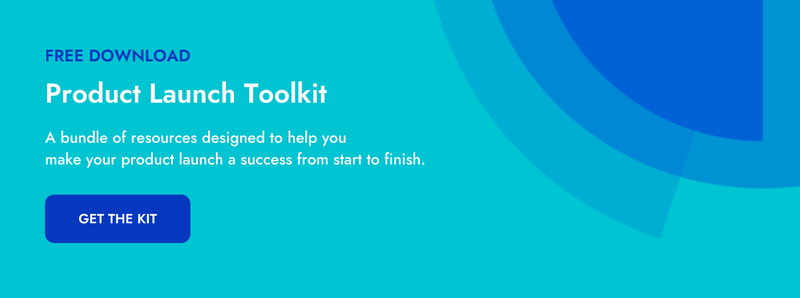Each product launch is like training for a race. You set up your timelines, train hard, and when it comes to race day, it’s all systems go when the gun goes off. But the path to the starting line is never cookie-cutter or straight. There’s a ton of action items that happen as you prepare and execute that make the launch a success. Many aren’t as simple as writing a datasheet or creating a narrative for how your feature helps the customer. Many are continuous or behind the scenes that help make the launch smoother from start to finish. Below are ten tips I’ve used, beyond the tactical execution, that have helped me nail launches in the past.
1. Start Early and Collaborate
A launch should be something you plan in tandem with the Product Managers at the same time that they start scoping their Epic and User Stories. Doing this will allow you to craft initial messaging and positioning so you can get feedback before it’s time to launch. I also recommend working on the press release (if you’re going to do one) as one of the first items during the initial discovery stage so you have a North Star. The point is not to use this as the published PR, but rather focus on clearly defining the customer challenge, how your method is different than the status quo, and how you’re able to provide exceptional value to the customer.
READY TO NAIL YOUR NEXT LAUNCH? DOWNLOAD OUR PRODUCT LAUNCH TOOLKIT ↓
READY TO NAIL YOUR NEXT LAUNCH? DOWNLOAD OUR PRODUCT LAUNCH TOOLKIT ↓
2. Establish Solid Success Criteria
It’s critical to set clear objectives and key results before the launch. It can be difficult to analyze the success of a launch if you don't first clarify what customer and business outcomes would constitute success.
3. Figure Out How Much Time to Invest and What to Do
Not all product launches are the same or will have the same impact on the business. I use a matrix to understand what type of launch I’m doing and map my activities to the chart, so the importance of the launch is mapped to the level of effort the team puts into it. A Tier 1 launch (Ex. new product) needs everything while a Tier 3 launch (Ex. feature update) has only some activities in each phase. You can see a sample product launch checklist at the end of this post for activities varying by launch tier.
4. Gain Buy-in From All Stakeholders and Build a Plan
Give yourself enough runway to ensure you’re able to give your launch the time and resources it deserves. Product launches are exciting and stressful, but the success is mainly dependent on if each team has enough cycles to execute against the plan. I recommend building out a launch plan (Gantt charts are great) so everyone stays on the same page.
5. Segment Your Plan
When you build out a launch plan, break down your launch into phases, and plan for each section. For example, I use the following phases: Research the market and competition, develop the buyer profile, synthesize the research and develop an initial positioning framework, socialize the initial product positioning for feedback, start building a launch plan, craft and develop the campaign, execute on the plan, GA!, measure success, debrief and get takeaways for next time.
6. Focus on Your Ideal Buyer
I’d suggest only focusing on the things that will impact your business and get the attention of your target audience. This means knowing your ideal buyer in and out. Choose initiatives that will promote your launch and only execute on activities that will drive awareness to that buyer or boost your brand equity. Just because you saw a company do something cool and unique for their launch doesn’t mean it’s right for your buyer or industry. Engage the right channels so that you’re showing up in your ideal buyers’ watering holes; the goal is to be visible where they go to get information or are part of the community to ensure you’re in their conversations.
7. Prime the Pump
Start adding in aspects of the value of your launch into your blogs, materials, etc. so you can start building SEO credit and the foundation to have the conversation about your new product or feature. That way, your product release compliments a story you’ve already started to develop. For example, at Upserve, we talked a lot about growing your operations and margins, so when we released an Inventory Management solution, it flowed seamlessly into the story we were telling about operational profit. You also need to make sure you don’t fall victim to what I call the “Big Bang and silence” phenomenon; it’s easy to make a big splash in the market, but the ongoing marketing and efforts to keep the momentum are paramount to your success in continuing the drive your message in the market. As much as you should prime the pump and make a big splash when you launch, you also need to ensure you avoid the silence after the release while you incorporate the new launch into all aspects of your messaging.
8. Arm Your Team
Give your team the appropriate content, talk tracks, and collateral that speaks contextually to that ideal buyer. Make sure they are trained. This should happen when you get the right resources developed and close to the launch so your GTM teams can start talking about the value prior to launch. As much as we try to stop it, sales reps love to sell ahead of their skis, so turn that enthusiasm into a benefit and enable them to do so. Sales should feel comfortable pitching the value. And make sure your customer success folks know how to position value to drive expansion revenue - something that’s often missed.
9. Measure Your Success and Learn for Next Time
Ask your team - What should we do more of next time? What should we do less of next time? What should we start doing? What should we not do? What is the adoption of the product/feature? What channels worked best? What is the feedback from buyers? Completing a retrospective, and following a standardized framework, is a fantastic way to make sure you’re constantly improving for next time.
10. Celebrate Adoption, Not the Launch
Going back to that race analogy, while you should be proud that months or weeks of training got you to the starting line, on launch day, it's just the beginning. Choose to instead celebrate the impact of the launch as you hit milestones and compare it to your expected "split times" - are customers adopting the new solution? Is there an impressive growth in new pipeline because of it? How has that impacted expansion revenue pipeline? Are we seeing net new leads come in? Internally, are the sales teams actively incorporating the new messaging to their demos and calls? If you're not hitting the milestones fast enough, just like a race, you might need to adjust your strategy. If all is well, now it’s time to celebrate. Grab a beer with your team. You (and they) have earned it.
If you follow these 10 tips, and utilize our product launch playbook, you will set up every product launch for success.

Seeing is believing! Check out Crayon for yourself.
Take a Product TourRelated Blog Posts
Popular Posts
-
 The 8 Free Market Research Tools and Resources You Need to Know
The 8 Free Market Research Tools and Resources You Need to Know
-
 How to Create a Competitive Matrix (Step-by-Step Guide With Examples + Free Templates)
How to Create a Competitive Matrix (Step-by-Step Guide With Examples + Free Templates)
-
 6 Competitive Advantage Examples From the Real World
6 Competitive Advantage Examples From the Real World
-
 24 Questions to Consider for Your Next SWOT Analysis
24 Questions to Consider for Your Next SWOT Analysis
-
 How to Measure Product Launch Success: 12 KPIs You Should Be Tracking
How to Measure Product Launch Success: 12 KPIs You Should Be Tracking



